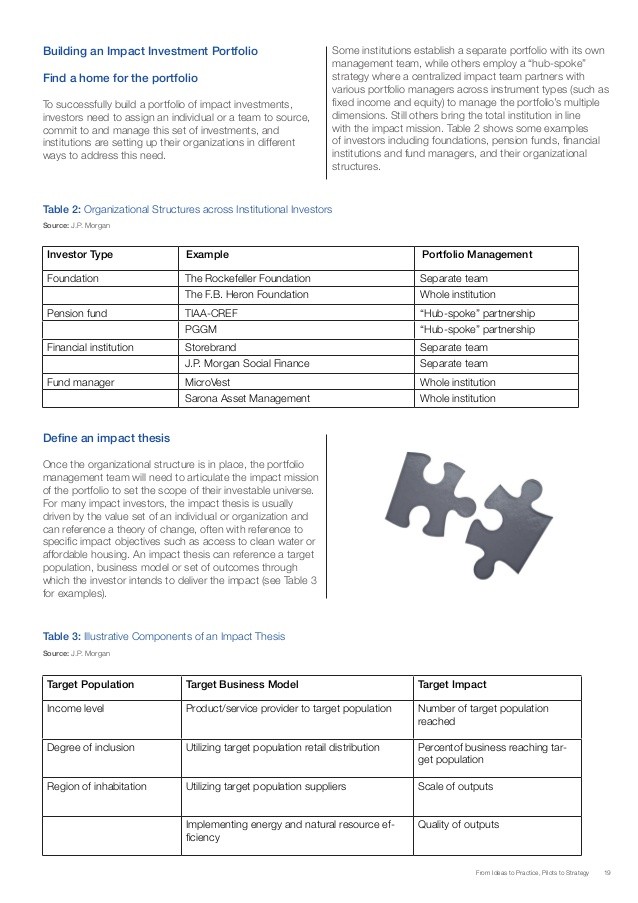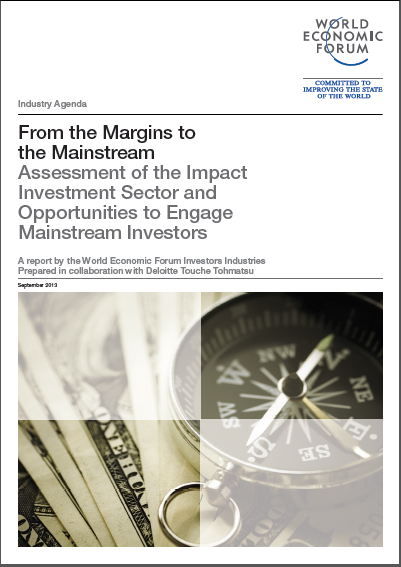Mainstream Impact Investing Reports World Economic Forum
Post on: 16 Март, 2015 No Comment

Mainstream institutional investors face constraints when trying to make impact investments under the rules and norms of their existing investment decision-making process. It is estimated that 66% of US-based pension funds agreed or strongly agreed with the statement: “It is difficult to fit these types of investments into my existing asset allocation framework.” This is primarily driven by the following reasons:
First, institutional investors manage the risk and return of their portfolios by considering a number of factors including, but not limited to: volatility, liquidity, portfolio match, exit timeline, investment style (growth versus value) and the investment size of various investment opportunities. These same considerations will also be made when institutional investors approach an impact investment. However, measuring these factors requires a certain level of data and track records that many impact enterprises (or impact investment funds) simply do not yet have. Similarly, it is difficult for institutional investors to fit “impact” metrics and social and environmental objectives into the theoretical frameworks, such as Modern Portfolio Theory, often used to ensure that portfolios are balanced, benchmarks are achieved, and risks are managed. Anecdotal evidence suggests that some impact investment funds have had experience overcoming this challenge through effective leadership (e.g. CIO, CEO, etc.) commitment to impact investing, and framing or use of familiar language. 79 Impact investment funds will be more effective raising capital by framing impact investing in terms of the diversification that new sectors or geographies offer, or as a play on value investing (social multiplier potentially boosts return).
The issue is ultimately about change management and not capital allocation.
Arthur Wood, Founding Partner,

Second, institutional investors are typically organized by asset class; identifying who the right decision-maker is can be a challenge because impact investing is an investment approach across asset classes. When US-based pension funds were asked into what asset class do they consider impact investments to fall, the results were fairly evenly distributed (see Figure 20 ), thus confirming the belief that impact investments span asset classes. As a result, institutional investors will struggle with execution regarding how to organize for impact investing. In some cases, institutional investors are better served by creating an entirely new team dedicated to impact investing rather than asking an existing team to augment their investment criteria. For example, TIAA-CREF has a team dedicated to evaluating the social and environmental performance on a deal-by-deal basis; once they have determined whether the deal meets key criteria and objectives, the team partners with the relevant asset class group, which then manages the deal through to completion. In other cases, it may make sense to have one person well-versed in impact investments to be a part of each asset class team and advocate on behalf of the impact investment opportunities.
Third, institutional investors make investment decisions based on formal processes, governance structures and investment mandates. Fiduciary duty is one key aspect of the investment decision-making process. Because there is uncertainty regarding the financial returns of impact investments as a result of their relative infrequency, structures or value propositions, fiduciary duty is at times cited as a reason why institutional investors are apprehensive about allocating capital to impact investments. Institutional Investors may thus avoid investments in new sectors – such as the impact investment sector – that may be perceived as “imprudent”. 80 In addition to fiduciary duty, the culture around the investment decision-making process can be a significant impediment for institutional investors. The process of engaging consultants, lawyers and advisers as investment decisions are made is systematic and familiar to the investment committees of most institutional investors. These individuals may be sceptical or biased against new and unfamiliar investment products, especially those that attempt to achieve social or environmental objectives as opposed to financial objectives; this bias is only heightened if the incentives of these individuals do not support the evaluation of goals other than financial performance.














